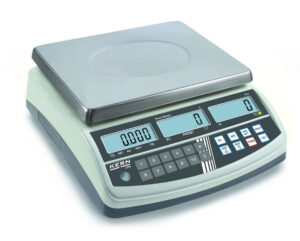Introduction
A Counting Scale is a precision instrument that calculates quantity by dividing the total weight of identical parts by the average piece weight. In fast moving operations, it replaces slow manual tallies with quick, traceable counts. Because the Counting Scale streamlines audits, kitting, and order fulfillment, it supports lean workflows in electronics, manufacturing, and retail.
How does a Counting Scale work?
Modern systems combine sensors, microcontrollers, and robust firmware to deliver reliable counts. The process is simple and repeatable.
-
Place a small sample to establish the piece weight, then add more parts.
-
The scale divides total mass by the stored piece weight to show quantity.
-
Built in functions handle tare, drift control, and stability checks for accuracy.
Inside the electronics
-
Load cell sensors capture force and convert it to signals processed by microprocessors.
-
Microcontrollers manage the display, switches, alerts, and communication with external controllers.
-
LED indicators show stability and counting status, while the display supports high contrast viewing on busy benches.
-
Power conditioning uses components such as a capacitor and fuses to protect circuits from surges.
Where does a Counting Scale add the most value?
Counting Scales accelerate tasks that depend on repeatable accuracy and speed.
-
Receiving: verify quantities of LEDs, capacitors, connectors, and fuses on arrival.
-
Kitting: assemble bags of screws, grips, and small tools with minimal error.
-
Inventory: cycle count bins for cables, switches, and contactors without halting lines.
-
Retail and service counters: check packs of fasteners or small electronics accessories.
What should you look for when selecting a Counting Scale?
Choosing the right model ensures confidence on day one and maintains accuracy over time.
-
Capacity and resolution: match the highest bin weight you expect and the smallest piece weight you need to resolve.
-
Internal counting resolution: prefer higher internal counts per division for fine parts such as SMD LEDs and microprocessors.
-
Minimum piece weight: confirm the scale can stably resolve very light items without drift.
-
Platform and pan design: pick a pan size that fits typical totes and provides a surface that resists oils and scratches.
-
User interface: look for tactile switches, clear LED cues, and fast menu access for operators wearing gloves.
-
Connectivity: support for USB, RS 232, or Ethernet enables data capture to laptops, label printers, and warehouse controllers.
-
Power and protection: check for fuses, surge suppression, and low power sleep to extend life in mixed duty cycles.
-
Construction and safety: sealed housings, corner overload protection, and non slip feet improve stability and safety on crowded benches.
Environmental and thermal factors
-
Temperature: thermal changes shift readings, so pick models with temperature compensation.
-
Materials: thermal pads and heat sinking near sensitive components reduce drift in warm spaces.
-
Cleanliness: oils and dust increase measurement noise; choose housings that wipe clean quickly.
How do Counting Scales integrate with your systems?
Digital workflows turn each count into usable data for planning and traceability.
-
Connect by cable to laptops for spreadsheets or to ERPs via API gateways.
-
Use barcode input to load part IDs and expected counts into the session.
-
Trigger I O signals with external switches or controllers to automate pass fail gates.
-
Interface to microcontrollers for custom fixtures that batch parts or actuate small conveyors.
How can you set up a Counting Scale for consistent results?
A good setup prevents rework and supports audit trails.
-
Use a representative sample size to define piece weight, especially for stamped or molded parts.
-
Keep bins, trays, and cables off the pan to avoid side loads on the sensors.
-
Tare containers every time and use identical trays across shifts to keep results repeatable.
-
Store piece weights for common items like connectors, LEDs, and capacitor assortments to save time.
What maintenance keeps your scale accurate?
Routine care protects sensors and electronics while limiting downtime.
-
Clean the pan daily and remove debris that could bind under the platform.
-
Inspect cables and connectors for strain and replace worn parts quickly.
-
Calibrate on a schedule using certified weights matched to your operating range.
-
Verify fuses and power supplies after outages to prevent nuisance faults.
Common mistakes to avoid
Small oversights can cascade into costly inventory discrepancies.
-
Using too small a sample for piece weight, which amplifies error on large batches.
-
Counting in locations with vibration or drafts near doors and fans.
-
Allowing oils and coolants to pool on the pan, which changes mass or causes slippage.
-
Ignoring thermal stabilization time after moving the scale between rooms.
What trends are shaping the next generation?
Emerging features extend accuracy, traceability, and uptime across the plant.
-
Smart sensors improve linearity and reduce warm up time for rapid starts.
-
Onboard analytics use microprocessors to flag anomalous counts and suggest resampling.
-
Wireless modules transmit results to mobile apps on laptops for instant sign off.
-
Edge controllers connect multiple stations, balancing lines and storing audit data locally.
Which Counting Scale fits your workflow?
Match the device to your parts mix and environment.
-
For light SMDs like LEDs and microprocessors: choose high resolution models with very low minimum piece weights.
-
For mixed fasteners and tools: mid capacity units with durable pans and bright displays support daily traffic.
-
For harsh or hot zones: sealed housings, thermal compensation, and replaceable cables maintain uptime.
A well chosen Counting Scale transforms inventory control into a fast, reliable process. With the right sensors, interfaces, and environmental protections, your team can count delicate electronics, hardware, and small assemblies with confidence. Build around stable power, clean conditions, and routine calibration, and your counts will remain accurate from receiving through shipment.


